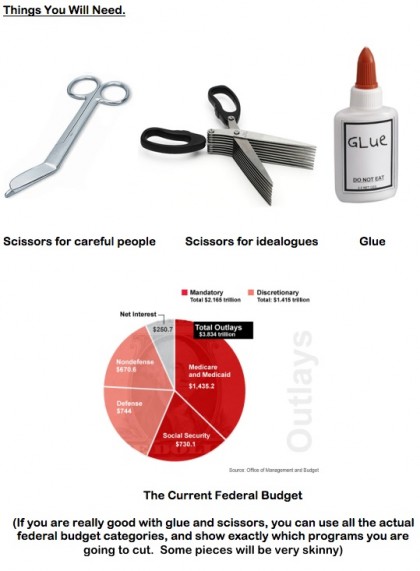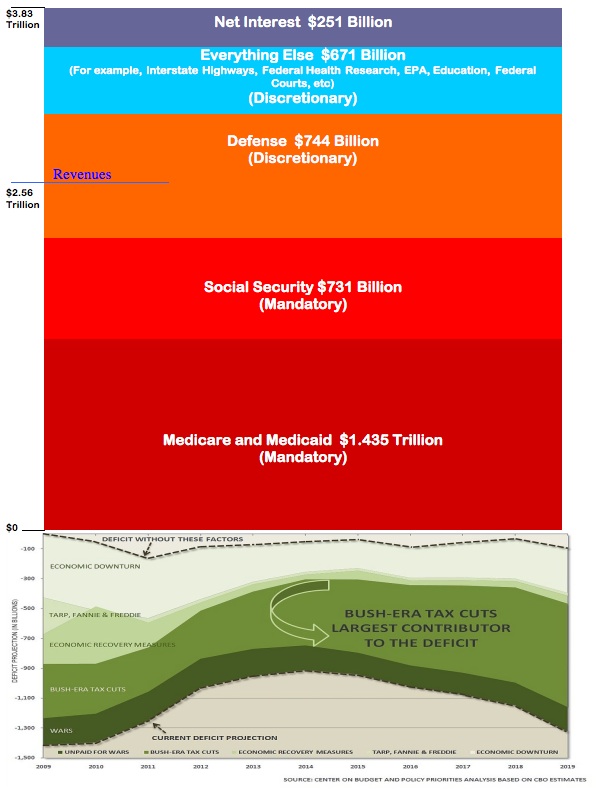There’s been so much talk about deficits and the budget, I’ve decided to come up with a visual Federal Budget Planner, using basic stuff you can find around the house so that children and students can understand what the grownups, especially those people who wear tea bags and tri-cornered hats, are so upset about. It will also be useful for politicians, pundits who are trying to get the politicians to tell them what they are going to do about the budgets and deficits and everyone else who is worried about them, or needs some basis in fact for talking about it. If we let people in Washington just hack away programs, the mantra for voters at the next election will be, “That’s not what we meant.”, so it is important to understand how the Budget Planner game is played. See if you can get your teacher to play the game with your class.
Gather up the tools to get started. Click on the images for a larger version.
Got all your stuff ready? Next, print out the following image as large as you can.
Now, we’re ready to start cutting the budget. Cut out all the solid boxes above the zero line out of the paper, leaving a square window. Make sure you leave the numbers on the left. Glue the paper with the hole onto a second sheet of paper so you can glue the boxes back in when you have cut them down to size. The next step is cut across each box to take off what you think we can save and still keep the country running. You can use a ruler and figure out how many inches per trillion dollars to tell you how much to cut. You can start out simply doing one year at a time. Figure out what will go away if you make the cuts.
If you just make cuts across the board to balance the budget with the revenues, you’ll cut everything by about a third…and things just won’t work and there will be hundreds of thousands more people unemployed. You might ask your grandparents if it is a good idea to cut social security, or ask your teacher about what she thinks about the cuts. Discretionary spending is what the President decides to put in the budget. If it is mandatory, then our elected officials have to change the law. This can cause a lot of fights in Washington.
Before you begin, here are a few things to consider. The green box at the bottom shows things that contributed to the deficit. Anything you can cut out of the green stuff ( which is shown year by year) lets you move the revenues upwards. That’s the line at $2.56 trillion on the left side of the budget, which is what we pay in taxes. For instance, if you cut out the unpaid-for wars and the Bush tax cuts, you could move that line up to nearly $3 trillion. If you put in any more new tax cuts, which is what a lot of people in Washington want to do, that will move the revenue line down. Way back in the 80’s the Government started cutting taxes on the rich and said we would get more revenues than the tax cuts cost. They called this the “Trickle Down ” theory. These people will get really mad if you ask them why you can’t raise revenues to help balance the budget, but it’s a good question. (If a grown up tells you the Trickle Down theory works, ask him to prove it. The country has been trying it for over 30 years with no luck) Fixing the economy would also move the revenues up by about $400 billion this year but this always takes time. If you have a really good way to quickly fix the deficit caused by the bad economy, please write as soon as possible to President Obama and your Congressman and Senator to let them know how it works.
To help you get started, the graphic has colored boxes that represent what we are spending in the current Federal Budget. It’s a good place to start. Cut off as many billions as you feel is OK from each box, and then glue them back into the right place on the graphic. The object of the game is to make sure that whatever is in these boxes after you have cut them down to size and glued in place fits below the revenue line.
You got everything to fit? The economy hasn’t crashed? Grandparents not mad at you?
Congratulations! You’ve balanced the federal budget! You’ve won! And God bless America.
P.S. Once you have played the game, especially if you cut a lot out of programs that your family uses and likes, like Social Security and grandparents,college loans for a brother or sister, or maybe Medicare, or maybe you know people who have lost their jobs and are on food stamps, you will see that it is not easy. President Clinton was the last president to balance the budget and he did it when the economy was doing well.
This game is very basic, but it’s purpose is to show that you can’t ignore the facts and just chant slogans and wave your arms around and hope to solve the country’s problems, which is what way too many supposed grownups are doing in Washington and especially on TV.



The post is quite interesting and I love the “toolkit”
for wanna-be budget-fixers at all levels of expertise,
which simplifies what you’ve previously referenced
in your “Russian River Times” article on alternative
health care models (Aug 31-Sep 30, 2009).
But seriously, can you comment on the Canadian health plan
model? It seems to me, if you eliminate the Bush tax cuts
and those two nasty “little” wars we’re still involved in,
the savings would be enough to wipe out the deficit.
Your thoughts?
You’re right, the overall savings to the U.S. economy would be bigger than the deficit. While federal health care spending would stay about the same under the Canadian model or most of the OECD countries, there would also be a huge savings to individuals, thus releasing @$3000 per person per year to the economy, adding a huge boost, plus making American manufacturers more competitive and undoing the portion of the deficit caused by the economic downturn. (Keep in mind that $1500 of the cost of an average U.S. new car represents the cost of providing health care to auto workers)
The trouble is that we insist on supporting a private health care ‘industry’ which doubles the cost compared with Canada and others. They’ve achieved a perfect trifecta of greed….the first billion dollar plus executive payout to “Dollar Bill” McGuire of United Health, the first multi- billion dollar fine (United Health/State of California) and billions of dollars of improper denials of payments and underpayments to doctors, according to the AMA.
Such practices cause America to spend @17% of GDP on health, vs. 9% of GDP for other economically developed countries. Investor Warren Buffet, in a 1 March 2010 CNBC interview stated, “…that kind of a cost compared to the rest of the world is ridiculous. It’s like a tapeworm eating at our economic body.” In spite of this expenditure, the US still ranks only 29th in health outcomes such as life expectancy. Sounds like we need a dose of tapeworm medicine.
Brilliance!
Thank you so much for this.
(Found by way of a comment in a Krugman thread at the NYT, IIRC — my digression / procrastination tree is… “irreducibly complex” might be a good way of putting it. OTOH, that might imply that I’m God… *wanders off to ruminate*)
O yeh, almost forgot:
in the graphic (“scissors for idealogues”) “idealogues” sb “ideologues”
Sorry, I have no choice; it’s in my contract — see tag. I thought for a very long time that “idealogue” did not exist as a word, except as a mis-spelling of “ideologue” — indeed, the spellcheck doesn’t recognize it at all. Turns out there IS such a word — at least as far as dictionary.com goes — with a meaning completely different from “ideologue.” Learn something new every day.
cheers
simfono apolita mazi sou.mpori men na thrteioe mavri komodia alla ego otan ida etouti edo tin tenia ixa sokaristi.apo tote den tin ksanaida.ida men tis neoteres tou solonz pou distixos den eftanan to epipedo tou happiness.Kseri kanis pou mporo na vro to welcome to the dollhouse?gia katevasma..